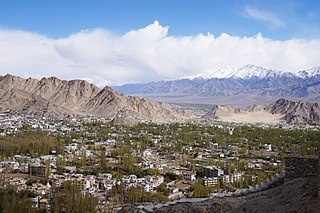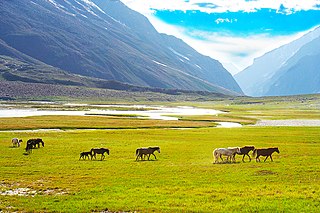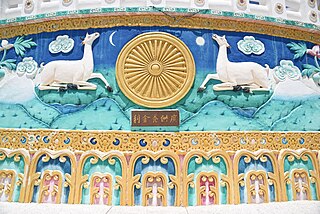
Ladakh is a region administered by India as a union territory and constitutes an eastern portion of the larger Kashmir region that has been the subject of a dispute between India and Pakistan since 1947 and India and China since 1959. Ladakh is bordered by the Tibet Autonomous Region to the east, the Indian state of Himachal Pradesh to the south, both the Indian-administered union territory of Jammu and Kashmir and the Pakistan-administered Gilgit-Baltistan to the west, and the southwest corner of Xinjiang across the Karakoram Pass in the far north. It extends from the Siachen Glacier in the Karakoram range to the north to the main Great Himalayas to the south. The eastern end, consisting of the uninhabited Aksai Chin plains, is claimed by the Indian Government as part of Ladakh, and has been under Chinese control since 1962.

Leh is a city in the union territory of Ladakh in India. It is the largest city and the joint capital of Ladakh. Leh, located in the Leh district, was also the historical capital of the Kingdom of Ladakh. The seat of the kingdom, Leh Palace, the former residence of the royal family of Ladakh, was built in the same style and about the same time as the Potala Palace in Tibet. Since they were both constructed in a similar style and at roughly the same time, the Potala Palace in Tibet and Leh Palace, the royal residence, are frequently contrasted. It's crucial to keep in mind, though, that Leh Palace lacks the same grandeur and historical significance as the Potala Palace. Although the assertion regarding the architectural period and timeline is frequently made. Leh is at an altitude of 3,524 m (11,562 ft), and is connected via National Highway 1 to Srinagar in the southwest and to Manali in the south via the Leh-Manali Highway.

Kargil district is a district in Indian-administered Ladakh in the disputed Kashmir-region. It is one of the two districts comprising the Indian-administered union territory of Ladakh. The district headquarters are in the city of Kargil. The district is bounded by the Indian-administered union territory of Jammu and Kashmir to the west, the Pakistani-administered administrative territory of Gilgit–Baltistan to the north, Ladakh's Leh district to the east, and the Indian state of Himachal Pradesh to the south. Encompassing three historical regions known as Purig, Dras and Zanskar, the district lies to the northeast of the Great Himalayas and encompasses the majority of the Zanskar Range. Its population inhabits the river valleys of the Dras, Suru, Wakha Rong, and Zanskar.

Leh district is a district in Indian-administered Ladakh in the disputed Kashmir-region. Ladakh is an Indian-administered union territory. With an area of 45,110 km2, it is the second largest district in the country, second only to Kutch. It is bounded on the north by Gilgit-Baltistan's Kharmang and Ghanche districts and Xinjiang's Kashgar Prefecture and Hotan Prefecture, to which it connects via the historic Karakoram Pass. Aksai Chin and Tibet are to the east, Kargil district to the west, and Lahul and Spiti to the south. The district headquarters is in Leh. It lies between 32 and 36 degree north latitude and 75 to 80 degree east longitude.

Kargil or Kargyil is a city in Indian-administered Ladakh in the Kashmir region. It is the joint capital of Ladakh, an Indian-administered union territory. It is also the headquarters of the Kargil district. It is the second-largest city in Ladakh after Leh. Kargil is located 204 kilometres (127 mi) east of Srinagar in Jammu and Kashmir, and 234 kilometres (145 mi) to the west of Leh. It is on the bank of the Suru River near its confluence with the Wakha Rong river, the latter providing the most accessible route to Leh.

Ladakh has a long history with evidence of human settlement from as back as 9000 b.c. It has been a crossroad of high Asia for thousands of years and has seen many cultures, empires and technologies born in its neighbours. As a result of these developments Ladakh has imported many traditions and culture from its neighbours and combining them all gave rise to a unique tradition and culture of its own.

The Ladakh Autonomous Hill Development Council, Leh is an Autonomous District Council that administers the Leh district of Ladakh, India.

The Suru Valley is a valley in the Kargil District in the Union Territory of Ladakh, India. It is drained by the Suru River, a tributary of the Indus River. The valley's most significant town is Sankoo.

Ladakh Buddhist Association (LBA) is an organization in Ladakh, India concerned with interests of Buddhists in Ladakh. It was founded in 1933 by King Jigmet Dadul Namgyal, Kalon Tsewang Rigzin, lachumir Munshi Sonam Tsewang and Kalon Bankapa Morup Gyaltsan

National Highway 1D, also known as Srinagar-Leh Highway, was a National Highway entirely within the union territory of Jammu and Kashmir and Ladakh in North India that connected Srinagar to Leh in Ladakh. It was one of the only two roads that connected Ladakh with the rest of India, the other being Leh-Manali Highway. The Srinagar-Leh Highway was declared as National Highway in 2006.

Lingshed Monastery or Lingshed Gompa is a Gelugpa Buddhist monastery in Ladakh, India. It is located near Lingshet village in the Leh district. It is 84 km north of Padum. It was founded in the 1440s by Changsems Sherabs Zangpo, disciple of Je Tsongkhapa, on a monastic site previously founded by the Translator Rinchen Zangpo. The monastery has belonged to the religious estate of Ngari Rinpoche since 1779. The Jangchub Tensung Dorje Center was founded in Lingshed by Kyabje Dagom Rinpoche in 1994.

Mulbekh Monastery or Mulbekh Gompa, at 11,495 ft from sea level and 656 ft uphill from road level, consists of 9 m (30 ft) tall Maitreya Buddha statue, 1400 CE kharosti language edicts on the hill, and two 800 years old gompas, Serdung gompa of Drukpa lineage and Rgaldan-se gompa of Gelugpa lineage of Buddhism, 40 km from Kargil on NH1 Kargil-Leh Highway in Kargil district of Ladakh in northern India. Monastery has large prayer wheels and view enroute the cliff monastery are stunning. Rgaldan-se Gompa, established by Tungba Lzawa who is also known as Agu Tungba, was renovated in 2016. Nyima Lhakhang temple was built around 800 years ago in the oldest section of the Mulbekh Monastery by the students of the great Tibetan scholar Lotsawa Rinchen Zangpo, it houses Lhakhang.

Zoji La is a high mountain pass in the Himalayas. It is in the Kargil district, Indian Union territory of Ladakh. Located in the Dras subdivision, the pass connects the Kashmir Valley to its west with the Dras and Suru valleys to its northeast and the Indus valley further east. National Highway #1 between Srinagar and Leh in the western section of the Himalayan mountain range, traverses the pass. As of late 2022, an all-weather Zoji-la Tunnel is under construction to mitigate seasonal road blockages due to heavy snowfall.

Chorbat Valley is a section of the Shyok river valley divided between Pakistan-administered Gilgit-Baltistan and Indian-administered Ladakh. The Pakistan-administered portion is in the Khaplu tehsil of Ghanche District in Gilgit–Baltistan, and the Indian-administered portion is in the Nubra tehsil, Leh district of Ladakh. Chorbat stretches from the edge of Khaplu to the Chalunka village of Nubra.

Ali Sher Khan Anchan was a famous Balti king. He was a Maqpon dynasty king who unified Baltistan and expanded its frontiers to Ladakh and western Tibet in the east, and in the west to the borders of Ghizar and Chitral.

Eliezer Joldan (1916-2001) was the first trained graduate to profess teaching as a profession in Ladakh. He was born in 1916 to Jonathan Tharchin Joldan and Chamnyet. He got his bachelor's degree in education from the Punjab University, Lahore. He died at the age of 85 at Leh. The Govt. Degree College at Leh is named after him. His students includes top political leaders, doctors, scholars and other intelligentsia of Ladakh on 23 June 2001. He would always prefer the traditional Ladakhi Goncha over western pants and shirts.
Chiktan or Chigtan is a village in the Kargil district, Ladakh, India. It is also the joint headquarters of the Shakar-Chiktan tehsil. It is situated on the right bank of the Sangeluma river, a tributary of the Indus River, which it joins near Sanjak opposite the village of Dah. Chiktan was the capital of the Cig-tan principality of Ladakh for several centuries.
Chering Dorjay is an Indian politician and was a member of the Bharatiya Janata Party. Dorjay was a member of the Jammu and Kashmir Legislative Council from the Assembly Kashmir (Ladakh). He was Minister for Cooperatives and Ladakh Affairs in Jammu and Kashmir till 19 June 2018.

Trespone is a scenic village in the TSG block of Sankoo tehsil in the Kargil district of the Indian union territory of Ladakh. Trespone is a historically, culturally, and architecturally rich village in the Suru Valley, located on the bank of the Suru River, and is around 20 km from Kargil town. It is often called little Kashmir, and is the gateway to Suru Valley. It is surrounded by five other villages, namely Saliskote, G.M.Pore, Tambis, Kanoor and Sarchey.

Nimmu–Padum–Darcha road (NPDR) or Zanskar Highway is a road under construction between the Indian union territory of Ladakh and the state of Himachal Pradesh, passing through the region of Zanskar. It connects Nimmu in the Indus Valley to Padum, the capital of Zanskar, to Darcha village in Lahul and Spiti. It provides an alternative to the Leh–Manali Highway in linking Ladakh with the rest of India. It is being built by the Border Roads Organisation (BRO) of the Indian army. Construction of road is expected to be completed by late 2023. The already completed Atal tunnel and the proposed Shingo La Tunnel which is expected to be completed by 2025 will provide all weather connectivity.



















